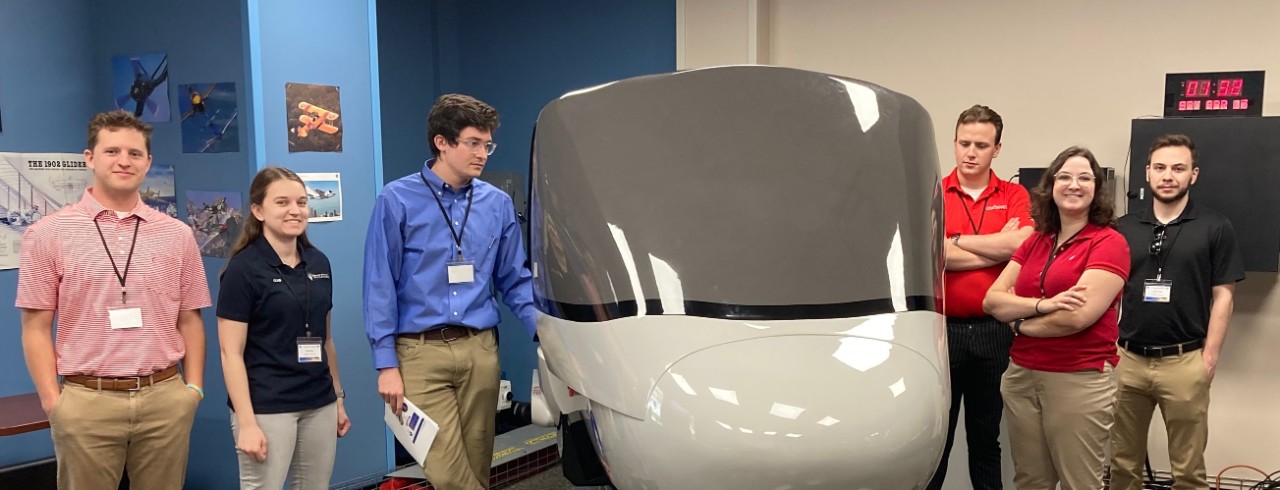
UC engineering students win aircraft design competition
Students competed in Merlin Flight Simulation Group's IT FLIES USA
Each year, the Merlin Flight Simulation Group holds an aircraft design and handling competition for university students. For the competition, students, individually or in groups, are tasked with creating and designing an aircraft that can fly. This year, a group of 16 University of Cincinnati senior aerospace engineering students from the College of Engineering and Applied Science (CEAS) entered their supersonic business jet in the competition and won.
The project was started as a capstone assignment for the senior-level Aircraft Design course in the Department of Aerospace Engineering and Engineering Mechanics within CEAS. The students, led by assistant professor educator Rodrigo Villalva, spent two semesters developing and designing a supersonic business jet within the set speed, range, takeoff field and passenger count requirements given to them.
The team created a basic concept that was refined throughout the two semesters they were in the class. Starting from the ground up, the students were tasked with designing and testing all features of the aircraft. They had to ensure the main components of an aircraft were placed in such a way that would allow it to fly safely.

Competition judge Frank Delsing and UC students Liam Mckenna and Daniel Driscoll stand in front of the flight simulator cockpit. Photo/Provided
"We spent roughly eight months developing and designing a supersonic aircraft from scratch that could operate in conditions outside of the capabilities of any current aircraft of this type and category," said Daniel Driscoll, chief engineer of the project. "Everything from the cockpit to the landing gear, to the engines, was carefully designed and optimized."
After completing the design and development process of the aircraft, the team chose to enter the IT FLIES USA competition to further test what they had built.
"The team opted to enter the competition to see how their design compared to other conceptual aircraft developed by students at other universities," Villalva said.
The competition took place at the University of Dayton in Dayton, Ohio, and aircraft were flown by test pilots, Frank Delsing, Gary Konnert and Aaron Tucker, using a flight simulator. The competition featured six varying aircraft entries and included a ten-minute presentation to the judges, along with the simulated test flight. The UC team won the flying portion of the competition by a unanimous vote. This marks the first winning team from UC at IT FLIES USA.
"I'm proud of what our team was able to achieve," said Liam Mckenna, stability and controls lead on the project. "My favorite part of it all was being able to hop into the cockpit of the design that my teammates and I worked so hard to create."
Throughout the design stages of this project, the students didn't know how their aircraft would perform in real-world conditions. The group spent two semesters conceptualizing and theorizing how this aircraft should perform but weren't able to really see it until the competition.
"It was a great joy to see all the theoretical aerodynamics put into the aircraft not only perform in a real-world simulation, but perform very well," said Josh Lupi, lead aerodynamics team engineer on the project.
Along with a first-place title, this experience provided the students with many valuable skills they will take with them and utilize in their future careers as engineers. The supersonic business jet was their final capstone project that led up to their graduation in May of 2023.
Every member of this team went above and beyond to reach our goals for this project
Daniel Driscoll, Chief engineer of the project and class of 2023 graduate
The students said they garnered skills such as the importance of documenting and saving findings and results during the design stage(s) of a project, team management, how to best work with a large group of individuals, improved technical presentation writing skills, working with other universities and more. They shared their appreciation for the guidance of Villalva and the collaboration with their team members throughout the eight-month process.
The members of the IT FLIES USA winning team: Daniel Driscoll, Liam Mckenna, Grace Fischer, Josh Lupi, Will Hausfeld, Kun-Lin Tsai, Alba Garcia Izquierdo, Alexis Laude, David Do, Emma Ochs, Jackson Dinga, Zachary Westgerdes, Brady McCluskey, Thomas Myers, Caleb Meredith and Charles Miller.
Featured Image at top: (From left to right) Will Hausfeld, Emma Ochs, Liam Mckenna, Jackson Dinga, Grace Fischer and Daniel Driscoll near the cockpit during the test flight. Photo/Provided
Related Stories
Ohio nurses weigh in on proposed federal loan rule
December 12, 2025
Spectrum News journalist Javari Burnett spoke with UC Dean Alicia Ribar and UC nursing students Megan Romero and Nevaeh Haskins about proposed new federal student loan rules. Romero and Haskins, both seniors, were filmed in the College of Nursing’s Simulation Lab.
Bearcat Mascot, Cheer Team and scholarships help celebrate Decision Day
December 12, 2025
Cincinnati media organization provided news coverage of Decision Day activities at the University of Cincinnati on Dec. 10, 2025. Surprise announcements of the 2026 Marian Spencer Scholarship recipient occurred during the day.
National inventors group recognizes UC provost
December 11, 2025
The National Academy of Inventors on Thursday named the interim provost of the University of Cincinnati to its 2025 class of fellows.


